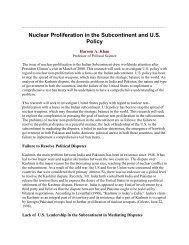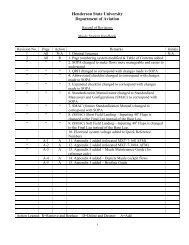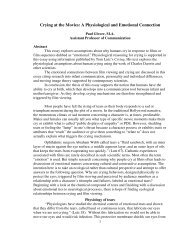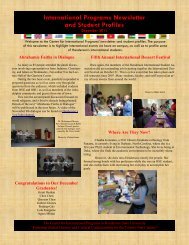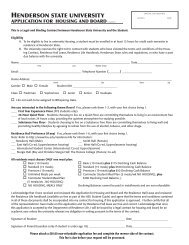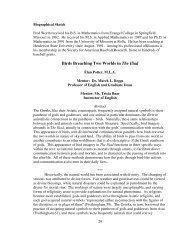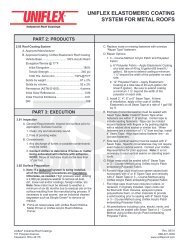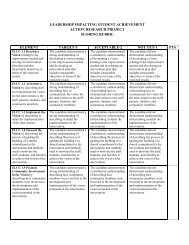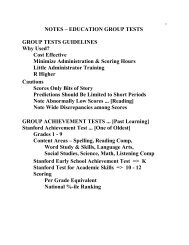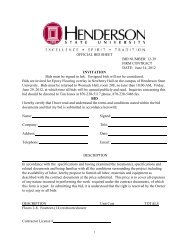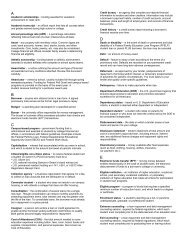Stage Check Study Guide - Comm. Lab II - Henderson State University
Stage Check Study Guide - Comm. Lab II - Henderson State University
Stage Check Study Guide - Comm. Lab II - Henderson State University
Create successful ePaper yourself
Turn your PDF publications into a flip-book with our unique Google optimized e-Paper software.
<strong>Henderson</strong> <strong>State</strong> <strong>University</strong><br />
Department of Aviation<br />
<strong>Comm</strong>ercial Pilot <strong>Lab</strong> <strong>II</strong><br />
<strong>Stage</strong> <strong>Check</strong> <strong>Study</strong> <strong>Guide</strong><br />
<strong>Comm</strong>ercial Pilot <strong>Lab</strong> <strong>II</strong> Page 1 of 27 REV 0<br />
<strong>Stage</strong> <strong>Check</strong> <strong>Study</strong> <strong>Guide</strong>
<strong>Comm</strong>. <strong>II</strong> <strong>Stage</strong> <strong>Check</strong>: Lesson 7<br />
1. Certificates and Documents<br />
a. Referenced to:<br />
i. 14 CFR parts 61.3(a)(c); 61.19; 61.23(a)(d); 61.56; 61.57 61.133(b);<br />
91.3; 91.203(a); 91.9(a)(b); 91.103<br />
ii. Airplane Flying Handbook, pages 2-1 to 2-2.<br />
iii. Pilot’s Handbook of Aeronautical Knowledge, pages 8-1 to 8-8<br />
iv. SOPA/AFM<br />
v. <strong>Comm</strong>ercial Pilot PTS<br />
b. Sample Questions:<br />
i. What certificates and documents do you need on your person to act as<br />
PIC?<br />
ii. What certificates and documents must be on board the aircraft before<br />
you can takeoff?<br />
iii. If an airworthiness certificate is in your airplane, does that mean that<br />
the airplane is always airworthy?<br />
iv. Who is directly responsible for and is the final authority to the<br />
operation of the aircraft? Explain what this means in your own words.<br />
v. What class of medical certificate must you have to act as PIC?<br />
vi.<br />
To act as PIC while carrying passengers, what must you do within the<br />
preceding 90 days? At night?<br />
vii. How do you stay current as a commercial pilot?<br />
c. Sample Scenario Based Questions:<br />
i. If you obtain a first class medical on August 14, 2009, what would be<br />
the last day you could act as PIC as a private pilot? What about<br />
commercial privileges?<br />
ii.<br />
2. Airworthiness Requirements<br />
What limitation will you have if you get your commercial certificate,<br />
but you do not have an instrument rating?<br />
Note: The student will be required to show airworthiness of the aircraft by finding the<br />
appropriate inspections in the aircraft logbooks.<br />
a. Referenced to:<br />
i. 14 CFR parts 91.7; 91.205(a-c); 91.207; 91.213; 91.215; 91.409(a-c);<br />
91.413.<br />
ii. PHAK pages 8-8 to 8-14.<br />
iii. <strong>Comm</strong>ercial Pilot PTS<br />
b. Sample Questions:<br />
i. What are the required instruments and equipment for VFR?<br />
ii. What are the required inspections that must be done to the airplane for<br />
it to remain airworthy?<br />
iii. How long is each inspection current?<br />
<strong>Comm</strong>ercial Pilot <strong>Lab</strong> <strong>II</strong> Page 2 of 27 REV 0<br />
<strong>Stage</strong> <strong>Check</strong> <strong>Study</strong> <strong>Guide</strong>
iv. Explain Airworthiness Directives to include definition, types, and<br />
compliance.<br />
v. Can you go flying without an ELT?<br />
vi. Who is responsible for determining the airworthiness of an airplane?<br />
c. Sample Scenario Based Questions:<br />
i. During your preflight inspection, you discover that the right side anticollision<br />
light is out, would you be allowed to fly the airplane? What if<br />
it was the landing light?<br />
ii. If you use the ELT, when will you have to replace the battery?<br />
iii. If the transponder in your airplane was inoperative, could you go fly?<br />
iv. If your airplane has 599 hours and the next 100-hour inspection is<br />
scheduled for 600 hours, under what conditions may you overfly 600<br />
hours?<br />
3. Weather Information<br />
a. Referenced to<br />
i. 14 CFR part 91.103<br />
ii. AC 00-6: Aviation Weather<br />
iii. AC 00-45: Aviation Weather Services<br />
iv. AC 61-84: Role of Preflight Preparation<br />
v. PHAK: Ch. 11 and Ch. 12<br />
vi. AIM: Ch. 7<br />
vii. <strong>Comm</strong>ercial Pilot PTS<br />
viii. Recommendation: Complete the weather-related courses on AOPA’s<br />
Air Safety Foundation online.<br />
b. Sample Questions:<br />
i. Explain METAR’s to include duration, how often they’re issued, and<br />
interpretation.<br />
ii. Explain TAF’s to include duration of forecast, how often they’re<br />
issued, and interpretation.<br />
iii. Explain FA’s to include duration of forecast, sections, how often<br />
they’re issued and interpretation.<br />
iv. Explain Winds and Temps aloft charts.<br />
v. Be familiar with Surface Analysis charts, Radar Summary charts,<br />
Prognostic charts, and Convective outlook charts.<br />
vi. What type or types of cloud bases are reported as ceilings?<br />
vii. Are cloud bases reported in AGL or MSL?<br />
viii. What is standard temperature and pressure?<br />
ix. What is the standard lapse rate?<br />
x. What are some of the elements you can expect to receive during a<br />
standard weather briefing?<br />
xi. What are the different types of weather briefings?<br />
xii. Who is responsible for making the go/no-go decision?<br />
xiii. What is EFAS? How do you use it?<br />
xiv. What is an AIRMET? What are the three types?<br />
<strong>Comm</strong>ercial Pilot <strong>Lab</strong> <strong>II</strong> Page 3 of 27 REV 0<br />
<strong>Stage</strong> <strong>Check</strong> <strong>Study</strong> <strong>Guide</strong>
xv. What is a SIGMET? What is the difference between a SIGMET and a<br />
Convective SIGMET?<br />
xvi. What is a PIREP? What makes them different from any other source of<br />
weather?<br />
xvii. What is HIWAS? How do you use it?<br />
c. Sample Scenario Based Questions:<br />
i. During the weather briefing for a night cross-country, the briefer<br />
advises you that the temperature is 21 o C and the dewpoint is 20 o C at<br />
your destination. What weather phenomenon could you expect to<br />
encounter when you arrive?<br />
ii. If a cold front passes over the airport, what can you expect to happen<br />
with the winds?<br />
iii. Should you ever fly through or under a thunderstorm even if you can<br />
see through the other side?<br />
iv. During a cross country flight, you observe some lightning and towering<br />
clouds along your intended route of flight. What could you do to find<br />
out about the position and direction of the bad weather?<br />
v. Can ATC help you avoid clouds?<br />
vi.<br />
4. Performance/Limitations<br />
During a night cross country flight, everything is going as planned, and<br />
you can see the ground lighting and horizon just fine. If everything<br />
started to disappear and the strobe lights began to blind you, what<br />
would you do?<br />
vii. If you got into a position where thunderstorm penetration was<br />
unavoidable, what would you do to help ensure the best outcome?<br />
viii. If you determine that you will be flying toward a low-pressure system,<br />
what kind of weather can you expect?<br />
ix. What is likely to form around an airport on calm, clear nights?<br />
x. If the dew point and temperature drop below freezing overnight, what<br />
is likely to form on the airplane?<br />
xi. During a weather briefing for a night cross-country flight, the briefer<br />
advises that fog is forecast along your route of flight. What would this<br />
look like when it forms around ground lighting? What would you do in<br />
this situation?<br />
xii. During a night flight back to M89, you tune up the AWSS and hear the<br />
visibility is ½ SM and sky’s overcast 200’. What is the likely cause?<br />
Your GPS says you’re over M89, but you can’t see the airport, what<br />
would you do?<br />
a. Referenced to:<br />
i. PHAK: pp. 4-1 to 4-39; 9-1 to 9-11; 10-1 to 10-26<br />
ii. Airplane Flying Handbook<br />
iii. AC 61-84: Role of Preflight Preparation<br />
iv. Piper POH<br />
v. <strong>Comm</strong>ercial Pilot PTS<br />
<strong>Comm</strong>ercial Pilot <strong>Lab</strong> <strong>II</strong> Page 4 of 27 REV 0<br />
<strong>Stage</strong> <strong>Check</strong> <strong>Study</strong> <strong>Guide</strong>
. Sample Questions:<br />
i. What are the two basic types of drag and how does each type vary with<br />
airspeed?<br />
ii. What is ground effect and how does it affect lift and drag on an<br />
airplane?<br />
iii. What are the two types of aircraft stability? How do aircraft<br />
manufacturers design stability into an aircraft<br />
iv. What aerodynamic force makes an airplane turn?<br />
v. How does load factor affect the stall speed of an airplane?<br />
vi. What causes a wing to stall?<br />
vii. What are the four main left turning tendencies?<br />
viii. What are the g-load limits for the arrow?<br />
ix. Is the arrow approved for spins?<br />
x. If you are in a steep bank turn (60 o ), what will be the load factor on the<br />
airplane?<br />
xi. What is maneuvering airspeed? Is it depicted on the airspeed indicator?<br />
xii. How does weight affect aircraft performance?<br />
xiii. How does CG location affect performance and stability?<br />
xiv. What is density altitude, and how do pressure, temperature, and<br />
moisture affect it?<br />
xv. What overall effect does density altitude have on an airplane?<br />
xvi. What are the different types of V-speeds and their corresponding<br />
instrument markings?<br />
xvii. What is the maximum demonstrated crosswind component for the<br />
arrow?<br />
c. Sample Scenario Based Questions:<br />
i. If you are flying below maneuvering speed and you put excess loads on<br />
the airplane, what will happen? What if you were flying above it?<br />
ii. At M89, what would be your takeoff distance over a 50-foot obstacle if<br />
the temperature is 30 o C, the airplane is 2500 lbs, and the winds are 180<br />
at 15 knots.<br />
5. Constant-speed Propeller<br />
a. Referenced to:<br />
i. PHAK: pp. 6-6 to 6-7<br />
ii. Airplane Flying Handbook: pp. 11-3 to 11-7<br />
iii. Piper POH<br />
b. Sample Questions:<br />
i. What are the advantages of a constant-speed propeller over a fixedpitch<br />
propeller?<br />
ii. Explain the operation of the constant-speed prop in the arrow ( i.e. how<br />
does the propeller maintain a constant rpm setting).<br />
<strong>Comm</strong>ercial Pilot <strong>Lab</strong> <strong>II</strong> Page 5 of 27 REV 0<br />
<strong>Stage</strong> <strong>Check</strong> <strong>Study</strong> <strong>Guide</strong>
6. Retractable Gear<br />
a. Referenced to:<br />
i. Airplane Flying Handbook: pp. 11-9 to 11-15<br />
ii. Piper POH<br />
b. Sample Questions:<br />
i. Explain the operation of the landing gear system in the arrow.<br />
ii. What are some airspeed limitations for the landing gear?<br />
iii. Why does the gear warning horn sound when you select gear up during<br />
a short field takeoff? What else will make the gear warning horn<br />
sound?<br />
iv. What are some things you could check during a potential gear failure?<br />
v. What airspeed should you maintain while doing an emergency gear<br />
extension?<br />
vi. What prevents the gear from retracting on the ground if you<br />
accidentally put the gear handle up?<br />
vii. If you had a total electrical failure, would you be able to put the gear<br />
down?<br />
7. Manifold Pressure Gauge and Tachometer Usage<br />
a. Referenced to:<br />
i. PHAK: pp. 6-6 to 6-7<br />
ii. Piper POH<br />
b. Sample Questions:<br />
i. What does MAP stand for?<br />
ii. If the engine isn’t running, what should the manifold pressure gauge<br />
indicate?<br />
iii. When you exercise the propeller during the runup, what does the MAP<br />
gauge indicate when you pull the prop lever back?<br />
iv. Is it true that the manifold pressure should never exceed engine rpm?<br />
For example: 26” and 2200 rpm.<br />
v. Why do you get a decrease in rpm when you pull the prop back?<br />
8. Operation of Systems<br />
a. Referenced to:<br />
i. PHAK: pp. 6-10 to 6-11; 7-12 to 7-15; 7-20<br />
ii. Piper POH<br />
iii. <strong>Comm</strong>ercial PTS<br />
b. Sample Questions:<br />
i. How does the fuel system work in the arrow?<br />
ii. Explain the electrical system in the arrow.<br />
iii. What does ADAHRS stand for?<br />
iv. What does the AHRS do?<br />
v. What is the purpose of the air data computer?<br />
<strong>Comm</strong>ercial Pilot <strong>Lab</strong> <strong>II</strong> Page 6 of 27 REV 0<br />
<strong>Stage</strong> <strong>Check</strong> <strong>Study</strong> <strong>Guide</strong>
vi. Is there a vacuum pump in the arrow?<br />
vii. What is the maximum amperage for the standby alternator?<br />
viii. How long should the internal battery of the standby attitude indicator<br />
last?<br />
c. Sample Scenario Based Questions:<br />
i. If the PFD is inoperative, can the airplane be dispatched? Can it be<br />
dispatched if the MFD is inop?<br />
ii. While checking the instruments before takeoff on an IFR flight, you<br />
test the standby attitude indicator battery, and it goes red. Should you<br />
continue the flight?<br />
iii. During a flight under IFR, you experience a total electrical failure.<br />
What should you do within one minute?<br />
iv. During flight you experience an alternator failure. What should you<br />
do?<br />
v. If you experience a PFD failure (i.e. red X’s on the heading, attitude,<br />
altitude, airspeed, etc.) what should you do?<br />
<strong>Comm</strong>ercial Pilot <strong>Lab</strong> <strong>II</strong> Page 7 of 27 REV 0<br />
<strong>Stage</strong> <strong>Check</strong> <strong>Study</strong> <strong>Guide</strong>
<strong>Comm</strong> <strong>II</strong> <strong>Stage</strong> <strong>Check</strong>: Lesson 16<br />
1. Certificates and Documents<br />
a. Referenced to:<br />
i. 14 CFR parts 1.1 61.3(a)(c); 61.19; 61.23(a)(d); 61.56; 61.57 61.133;<br />
91.3; 91.203(a); 91.9(a)(b); 91.103; 119.1<br />
ii. Airplane Flying Handbook, pages 2-1 to 2-2.<br />
iii. Pilot’s Handbook of Aeronautical Knowledge, pages 8-1 to 8-8<br />
iv. AC 120-12A<br />
v. <strong>Comm</strong>ercial Pilot PTS<br />
b. Sample Questions:<br />
i. What certificates and documents do you need on your person to act as<br />
PIC?<br />
ii. What certificates and documents must be on board the aircraft before<br />
you can takeoff?<br />
iii. If an airworthiness certificate is in your airplane, does that mean that<br />
the airplane is always airworthy?<br />
iv. Who is directly responsible for and is the final authority to the<br />
operation of the aircraft? Explain what this means in your own words.<br />
v. What class of medical certificate must you have to act as PIC during<br />
vi.<br />
commercial operations?<br />
To act as PIC while carrying passengers, what must you do within the<br />
preceding 90 days? At night?<br />
vii. How do you stay current as a commercial pilot?<br />
viii. What is the difference between a common carrier and a private carrier?<br />
ix. If you work for a corporate flight department, would that be part 91,<br />
135, or 121?<br />
c. Sample Scenario Based Questions:<br />
i. If you obtain a first class medical on August 14, 2009, what would be<br />
the last day you could act as PIC as a private pilot? What about<br />
commercial privileges?<br />
ii.<br />
What limitation will you have if you get your commercial certificate,<br />
but you do not have an instrument rating?<br />
iii. A man approaches you at the airport and asks if you can fly him in his<br />
baron to Florida for the weekend. He tells you he lost his medical<br />
recently, and he will pay you $100 a day. Would you be breaking any<br />
regulations if you accepted the job?<br />
iv.<br />
If you own your own airplane and you give flight instruction, do you<br />
have to hold a part 135 certificate?<br />
<strong>Comm</strong>ercial Pilot <strong>Lab</strong> <strong>II</strong> Page 8 of 27 REV 0<br />
<strong>Stage</strong> <strong>Check</strong> <strong>Study</strong> <strong>Guide</strong>
2. Airworthiness Requirements<br />
Note: The student will be required to show airworthiness of the aircraft by finding the<br />
appropriate inspections in the aircraft logbooks.<br />
a. Referenced to:<br />
i. 14 CFR parts 91.7; 91.205(a-c); 91.207; 91.213; 91.215; 91.409(a-c);<br />
91.413.<br />
ii. PHAK pages 8-8 to 8-14.<br />
iii. <strong>Comm</strong>ercial Pilot PTS<br />
b. Sample Questions:<br />
i. What are the required instruments and equipment for VFR?<br />
ii. What are the required inspections that must be done to the airplane for<br />
it to remain airworthy?<br />
iii. How long is each inspection current?<br />
iv. Explain Airworthiness Directives to include definition, types, and<br />
compliance.<br />
v. Can you go flying without an ELT?<br />
vi. Who is responsible for determining the airworthiness of an airplane?<br />
c. Sample Scenario Based Questions:<br />
i. If the left nav light is out, would the airplane be airworthy?<br />
ii. If you use the ELT, when will you have to replace the battery?<br />
iii. If the transponder in your airplane was inoperative, could you go fly?<br />
iv. If your airplane has 599 hours and the next 100-hour inspection is<br />
scheduled for 600 hours, under what conditions may you overfly 600<br />
hours?<br />
3. Weather Information<br />
a. Referenced to<br />
i. 14 CFR part 91.103<br />
ii. AC 00-6: Aviation Weather<br />
iii. AC 00-45: Aviation Weather Services<br />
iv. AC 61-84: Role of Preflight Preparation<br />
v. PHAK: Ch. 11 and Ch. 12<br />
vi. AIM: Ch. 7<br />
vii. <strong>Comm</strong>ercial Pilot PTS<br />
viii. Recommendation: Complete the weather-related courses on AOPA’s<br />
Air Safety Foundation online.<br />
b. Sample Questions:<br />
i. Explain METAR’s to include duration, how often they’re issued, and<br />
interpretation.<br />
ii. Explain TAF’s to include duration of forecast, how often they’re<br />
issued, and interpretation.<br />
iii. Explain FA’s to include duration of forecast, sections, how often<br />
they’re issued and interpretation.<br />
<strong>Comm</strong>ercial Pilot <strong>Lab</strong> <strong>II</strong> Page 9 of 27 REV 0<br />
<strong>Stage</strong> <strong>Check</strong> <strong>Study</strong> <strong>Guide</strong>
iv. Explain Winds and Temps aloft charts.<br />
v. Be familiar with Surface Analysis charts, Radar Summary charts,<br />
Prognostic charts, and Convective outlook charts.<br />
vi. What type or types of cloud bases are reported as ceilings?<br />
vii. Are cloud bases reported in AGL or MSL?<br />
viii. What is standard temperature and pressure?<br />
ix. What is the standard lapse rate?<br />
x. What are some of the elements you can expect to receive during a<br />
standard weather briefing?<br />
xi. What are the different types of weather briefings?<br />
xii. Who is responsible for making the go/no-go decision?<br />
xiii. What is EFAS? How do you use it?<br />
xiv. What is an AIRMET? What are the three types?<br />
xv. What is a SIGMET? What is the difference between a SIGMET and a<br />
Convective SIGMET?<br />
xvi. What is a PIREP? What makes them different from any other source of<br />
weather?<br />
xvii. What is HIWAS? How do you use it?<br />
c. Sample Scenario Based Questions:<br />
i. During the weather briefing for a night cross-country, the briefer<br />
advises you that the temperature is 21 o C and the dewpoint is 20 o C at<br />
your destination. What weather phenomenon could you expect to<br />
encounter when you arrive?<br />
ii. If a cold front passes over the airport, what can you expect to happen<br />
with the winds?<br />
iii. Should you ever fly through or under a thunderstorm even if you can<br />
see through the other side?<br />
iv. During a cross country flight, you observe some lightning and towering<br />
clouds along your intended route of flight. What could you do to find<br />
out about the position and direction of the bad weather?<br />
v. Can ATC help you avoid clouds?<br />
vi. During a night cross country flight, everything is going as planned, and<br />
you can see the ground lighting and horizon just fine. If everything<br />
started to disappear and the strobe lights began to blind you, what<br />
would you do?<br />
vii. If you got into a position where thunderstorm penetration was<br />
unavoidable, what would you do to help ensure the best outcome?<br />
viii. If you determine that you will be flying toward a low-pressure system,<br />
what kind of weather can you expect?<br />
ix. What is likely to form around an airport on calm, clear nights?<br />
x. If the dewpoint and temperature drop below freezing overnight, what is<br />
likely to form on the airplane?<br />
<strong>Comm</strong>ercial Pilot <strong>Lab</strong> <strong>II</strong> Page 10 of 27 REV 0<br />
<strong>Stage</strong> <strong>Check</strong> <strong>Study</strong> <strong>Guide</strong>
4. National Airspace System<br />
a. Referenced to:<br />
i. 14 CFR parts 71; 91.117; 91.119; 91.126; 91.127; 91.129; 91.130;<br />
91.131; 91.133; 91.135; 91.137; 91.141; 91.145; 91.155; 91.157;<br />
91.215<br />
ii. AIM: Ch. 3<br />
iii. PHAK: Ch. 14<br />
iv. <strong>Comm</strong>ercial Pilot PTS<br />
v. Aeronautical Charts<br />
vi. Recommendation: Complete the Airspace courses on AOPA’s Air<br />
Safety Foundation online.<br />
b. Sample Questions:<br />
i. Explain Class A, B, C, D, E, and G airspace to include pilot and<br />
equipment requirements for entry, dimensions, and clouds/visibility<br />
requirements.<br />
ii. What type of airspace is Class G airspace? Where is it depicted on a<br />
sectional?<br />
iii. What are the clouds/visibility requirements for Class G? Class E, D,<br />
etc.<br />
iv. Can you fly through an MOA?<br />
v. Are you allowed to traverse a Restricted Area?<br />
vi. What is a TFR? How can you find out information about them?<br />
vii. What is a TRSA? Can you fly through one without a transponder?<br />
viii. How would you get a special VFR clearance? Can you get one at<br />
night? Can you get special VFR into or out of M89?<br />
ix. What equipment do you have to have to enter class D airspace? Class<br />
C, B, A?<br />
x. Where does class E start over M89? Over KHOT? Over areas other<br />
than airports? How high does it go?<br />
xi. What are the typical dimensions for class D and C airspace?<br />
xii. To act as PIC in class B airspace, what type of pilot certificate must<br />
you have?<br />
xiii. Can you overfly class D airspace without a transponder? Class C?<br />
xiv. If you are flying above 10,000’ MSL, what equipment will you need?<br />
xv. Where can you find information about active times for MOAs on a<br />
sectional chart?<br />
xvi. What is the speed limit for airplanes below 10,000’ MSL?<br />
xvii. How low can you fly over a congested area?<br />
c. Sample Scenario Based Questions:<br />
i. If the weather is 900’ overcast and 2 SM visibility, can you takeoff out<br />
of Arkadelphia? What about KHOT?<br />
ii.<br />
What do the clouds and visibility need to be to takeoff out of<br />
Texarkana? What about KLIT?<br />
<strong>Comm</strong>ercial Pilot <strong>Lab</strong> <strong>II</strong> Page 11 of 27 REV 0<br />
<strong>Stage</strong> <strong>Check</strong> <strong>Study</strong> <strong>Guide</strong>
iii. Would it be legal for you to fly from Sheridan, AR to KHOT with 900’<br />
ceilings and 10 SM visibility? Could you takeoff out of KHOT with<br />
weather like this? If not, what would you need to do?<br />
iv. If there is a low ceiling of 800’ over Pine Bluff airport, but the weather<br />
is clear across your route all the way to your destination, what could<br />
you do to legally takeoff out of PBF? What if it was at night?<br />
v. If the transponder in your airplane is inoperative, could you fly from<br />
vi.<br />
M89 to Searcy, AR at 5,500’?<br />
En route to Fort Smith, AR, your alternator fails and you lose all<br />
electrical, what will you have to do before you land there?<br />
vii. While trying to establish radio communication with Little Rock<br />
Approach, they say “aircraft calling standby.” Can you continue into<br />
class C airspace?<br />
viii. On a cross country flight while under flight following, you notice a<br />
cloud layer approaching at your altitude, what are you going to do?<br />
ix.<br />
Are you legal if you are overflying KLIT at 5,500’ and the cloud tops<br />
are at 5,000’?<br />
x. Would you be legal if you wanted to practice takeoffs and landings at<br />
Gurdon during night hours with the visibility restricted to 2 SM<br />
because of haze?<br />
xi. Can you go into KFSM without a transponder?<br />
xii. Would you be legal if you flew from Pine Bluff to West Memphis, AR<br />
without a transponder even if you remain clear of Class B airspace?<br />
xiii. When you takeoff out of North Little Rock airport on a cross country to<br />
M89, what do you need to do as soon as practicable after departing?<br />
xiv. If you are flying through class D airspace with the negative flaps in,<br />
how fast are you allowed to go?<br />
xv. If you need to fly to Little Rock Adams Field and your airplane is not<br />
equipped with a transponder, is there any way you could make the<br />
flight?<br />
xvi. If you haven’t logged any instrument approaches in the past year,<br />
would you be able to takeoff out of KHOT with 3,000’ ceilings and 2<br />
SM visibility?<br />
5. Cross-Country Flight Planning<br />
Cross-country planning should be completed before the beginning of the stage check. Since<br />
this flight will be conducted under IFR, instrument cross country procedures will be<br />
discussed.<br />
a. Referenced to:<br />
i. Instrument Flying Handbook: pp. 8-27; 10-2 to 10-3<br />
ii. Instrument Procedures Handbook: pp. 2-11<br />
iii. 14 CFR parts 91.103; 91.167; 91.169; 91.177; 91.179; 91.181<br />
iv. AIM: 1-1-19; 1-1-20; 5-1 (Preflight)<br />
b. Sample Questions:<br />
<strong>Comm</strong>ercial Pilot <strong>Lab</strong> <strong>II</strong> Page 12 of 27 REV 0<br />
<strong>Stage</strong> <strong>Check</strong> <strong>Study</strong> <strong>Guide</strong>
i. What kind of information is required for an IFR flight plan?<br />
ii. What information must you be familiar with when planning an IFR<br />
flight?<br />
iii. When planning an IFR flight, how much fuel should you plan to have<br />
remaining when arriving at your destination? What if you have to file an<br />
alternate?<br />
iv. If you have more than one altitude in your flight plan, which one should<br />
you file?<br />
v. Under what conditions may you exclude an alternate airport in your<br />
flight plan?<br />
vi. What are standard alternate weather minimums for a precision approach?<br />
What about non-precision?<br />
vii. How do you determine whether or not an airport can be used as an<br />
alternate?<br />
viii. If you have to file an alternate airport, what weather conditions must be<br />
forecast at that airport to use it as an alternate?<br />
ix. Can you file IFR to an airport that has no instrument approaches<br />
published? Explain why or why not.<br />
x. Can you file as an alternate an airport that has no instrument approaches<br />
published? Why or why not?<br />
xi. Can you file as an alternate an airport that has only RNAV (GPS)<br />
approaches published?<br />
xii. If you will be using GPS on your cross country, how can you find out<br />
information about the status of the satellites and RAIM availability for<br />
your route?<br />
xiii. If RAIM is predicted to be unavailable during any portion of your route,<br />
how should you plan your cross country?<br />
xiv. Which NOTAM’s include amendments to aeronautical charts or IAP’s?<br />
xv. If an airport does not have weather reporting, will you be able to use it as<br />
an alternate?<br />
xvi. If your flight plan route takes you on a heading of 300, what altitude<br />
would you file?<br />
c. Sample Scenario Based Questions:<br />
i. Your boss needs you to fly to Tumbleweed County Airport, and during<br />
your preflight planning, you discover it has no instrument approaches<br />
published. There isn’t a cloud within 500 miles of your proposed route.<br />
Can you exclude an alternate airport from your flight plan?<br />
ii. You need to fly to an airport that does not have approach procedures, and<br />
the Area Forecast for the area is calling for overcast clouds around 2 to<br />
3,000’. What could you do to legally get out of the clouds without<br />
executing an approach?<br />
6. Performance/Limitations<br />
a. Referenced to:<br />
i. PHAK: pp. 4-1 to 4-39; 9-1 to 9-11; 10-1 to 10-26<br />
<strong>Comm</strong>ercial Pilot <strong>Lab</strong> <strong>II</strong> Page 13 of 27 REV 0<br />
<strong>Stage</strong> <strong>Check</strong> <strong>Study</strong> <strong>Guide</strong>
8. Supplemental Oxygen<br />
a. Referenced to:<br />
i. 14 CFR Part 91.211<br />
ii. PHAK: pp. 6-34 to 6-37<br />
iii. <strong>Comm</strong>ercial Pilot PTS<br />
b. Sample Questions:<br />
i. What are the oxygen requirements for flight above 12,500’? What<br />
about 14,000’ and 15,000’?<br />
ii. What is unique about aviation oxygen?<br />
9. Pressurization<br />
a. Referenced to:<br />
i. PHAK: pp. 6-32 to 6-34<br />
ii. 14 CFR part 61.31(g)<br />
iii. <strong>Comm</strong>ercial Pilot PTS<br />
b. Sample Questions:<br />
i. Explain the basic operation of a pressurization system.<br />
ii. Is there any endorsement required to act as PIC in a pressurized<br />
aircraft?<br />
<strong>Comm</strong>ercial Pilot <strong>Lab</strong> <strong>II</strong> Page 15 of 27 REV 0<br />
<strong>Stage</strong> <strong>Check</strong> <strong>Study</strong> <strong>Guide</strong>
<strong>Comm</strong>. <strong>II</strong> <strong>Stage</strong> <strong>Check</strong>: Lesson 24<br />
1. Certificates and Documents<br />
a. Referenced to:<br />
i. 14 CFR parts 1.1 61.3(a)(c); 61.19; 61.23(a)(d); 61.56; 61.57 61.133;<br />
91.3; 91.203(a); 91.9(a)(b); 91.103; 119.1<br />
ii. Airplane Flying Handbook, pages 2-1 to 2-2.<br />
iii. Pilot’s Handbook of Aeronautical Knowledge, pages 8-1 to 8-8<br />
iv. AC 120-12A<br />
v. <strong>Comm</strong>ercial Pilot PTS<br />
b. Sample Questions:<br />
i. What certificates and documents do you need on your person to act as<br />
PIC?<br />
ii. What certificates and documents must be on board the aircraft before<br />
you can takeoff?<br />
iii. If an airworthiness certificate is in your airplane, does that mean that<br />
the airplane is always airworthy?<br />
iv. Who is directly responsible for and is the final authority to the<br />
operation of the aircraft? Explain what this means in your own words.<br />
v. What class of medical certificate must you have to act as PIC during<br />
vi.<br />
commercial operations?<br />
To act as PIC while carrying passengers, what must you do within the<br />
preceding 90 days? At night?<br />
vii. How do you stay current as a commercial pilot?<br />
viii. What is the difference between a common carrier and a private carrier?<br />
ix. If you work for a corporate flight department, would that be part 91,<br />
135, or 121?<br />
c. Sample Scenario Based Questions:<br />
i. If you obtain a first class medical on August 14, 2009, what would be<br />
the last day you could act as PIC as a private pilot? What about<br />
commercial privileges?<br />
ii.<br />
What limitation will you have if you get your commercial certificate,<br />
but you do not have an instrument rating?<br />
iii. A man approaches you at the airport and asks if you can fly him in his<br />
baron to Florida for the weekend. He tells you he lost his medical<br />
recently, and he will pay you $100 a day. Would you be breaking any<br />
regs if you accepted the job?<br />
iv.<br />
2. Airworthiness Requirements<br />
If you own your own airplane and you give flight instruction, do you<br />
have to hold a part 135 certificate?<br />
Note: The student will be required to show airworthiness of the aircraft by finding the<br />
appropriate inspections in the aircraft logbooks.<br />
<strong>Comm</strong>ercial Pilot <strong>Lab</strong> <strong>II</strong> Page 16 of 27 REV 0<br />
<strong>Stage</strong> <strong>Check</strong> <strong>Study</strong> <strong>Guide</strong>
a. Referenced to:<br />
i. 14 CFR parts 91.7; 91.205(a-c); 91.207; 91.213; 91.215; 91.409(a-c);<br />
91.413.<br />
ii. PHAK pages 8-8 to 8-14.<br />
iii. <strong>Comm</strong>ercial Pilot PTS<br />
b. Sample Questions:<br />
i. What are the required instruments and equipment for VFR?<br />
ii. What are the required inspections that must be done to the airplane for<br />
it to remain airworthy?<br />
iii. How long is each inspection current?<br />
iv. Explain Airworthiness Directives to include definition, types, and<br />
compliance.<br />
v. Can you go flying without an ELT?<br />
vi. Who is responsible for determining the airworthiness of an airplane?<br />
c. Sample Scenario Based Questions:<br />
i. If the left nav light is out, would the airplane be airworthy?<br />
ii. If you use the ELT, when will you have to replace the battery?<br />
iii. If the transponder in your airplane was inoperative, could you go fly?<br />
iv. If your airplane has 599 hours and the next 100-hour inspection is<br />
scheduled for 600 hours, under what conditions may you overfly 600<br />
hours?<br />
3. Weather Information<br />
a. Referenced to<br />
i. 14 CFR part 91.103<br />
ii. AC 00-6: Aviation Weather<br />
iii. AC 00-45: Aviation Weather Services<br />
iv. AC 61-84: Role of Preflight Preparation<br />
v. PHAK: Ch. 11 and Ch. 12<br />
vi. AIM: Ch. 7<br />
vii. <strong>Comm</strong>ercial Pilot PTS<br />
viii. Recommendation: Complete the weather-related courses on AOPA’s<br />
Air Safety Foundation online.<br />
b. Sample Questions:<br />
i. Explain METAR’s to include duration, how often they’re issued, and<br />
interpretation.<br />
ii. Explain TAF’s to include duration of forecast, how often they’re<br />
issued, and interpretation.<br />
iii. Explain FA’s to include duration of forecast, sections, how often<br />
they’re issued and interpretation.<br />
iv. Explain Winds and Temps aloft charts.<br />
v. Be familiar with Surface Analysis charts, Radar Summary charts,<br />
Prognostic charts, and Convective outlook charts.<br />
vi. What type or types of cloud bases are reported as ceilings?<br />
vii. Are cloud bases reported in AGL or MSL?<br />
<strong>Comm</strong>ercial Pilot <strong>Lab</strong> <strong>II</strong> Page 17 of 27 REV 0<br />
<strong>Stage</strong> <strong>Check</strong> <strong>Study</strong> <strong>Guide</strong>
viii. What is standard temperature and pressure?<br />
ix. What is the standard lapse rate?<br />
x. What are some of the elements you can expect to receive during a<br />
standard weather briefing?<br />
xi. What are the different types of weather briefings?<br />
xii. Who is responsible for making the go/no-go decision?<br />
xiii. What is EFAS? How do you use it?<br />
xiv. What is an AIRMET? What are the three types?<br />
xv. What is a SIGMET? What is the difference between a SIGMET and a<br />
Convective SIGMET?<br />
xvi. What is a PIREP? What makes them different from any other source of<br />
weather?<br />
xvii. What is HIWAS? How do you use it?<br />
c. Sample Scenario Based Questions:<br />
i. During the weather briefing for a night cross-country, the briefer<br />
advises you that the temperature is 21 o C and the dew point is 20 o C at<br />
your destination. What weather phenomenon could you expect to<br />
encounter when you arrive?<br />
ii. If a cold front passes over the airport, what can you expect to happen<br />
with the winds?<br />
iii. Should you ever fly through or under a thunderstorm even if you can<br />
see through the other side?<br />
iv. During a cross country flight, you observe some lightning and towering<br />
clouds along your intended route of flight. What could you do to find<br />
out about the position and direction of the bad weather?<br />
v. Can ATC help you avoid clouds?<br />
vi. During a night cross country flight, everything is going as planned, and<br />
you can see the ground lighting and horizon just fine. If everything<br />
started to disappear and the strobe lights began to blind you, what<br />
would you do?<br />
vii. If you got into a position where thunderstorm penetration was<br />
unavoidable, what would you do to help ensure the best outcome?<br />
viii. If you determine that you will be flying toward a low-pressure system,<br />
what kind of weather can you expect?<br />
ix. What is likely to form around an airport on calm, clear nights?<br />
x. If the dew point and temperature drop below freezing overnight, what<br />
is likely to form on the airplane?<br />
4. Performance/Limitations<br />
a. Referenced to:<br />
i. PHAK: pp. 4-1 to 4-39; 9-1 to 9-11; 10-1 to 10-26<br />
ii. Airplane Flying Handbook<br />
iii. AC 61-84: Role of Preflight Preparation<br />
iv. Piper POH<br />
v. <strong>Comm</strong>ercial Pilot PTS<br />
<strong>Comm</strong>ercial Pilot <strong>Lab</strong> <strong>II</strong> Page 18 of 27 REV 0<br />
<strong>Stage</strong> <strong>Check</strong> <strong>Study</strong> <strong>Guide</strong>
. Sample Questions:<br />
i. What are the two basic types of drag and how does each type vary with<br />
airspeed?<br />
ii. What is ground effect and how does it affect lift and drag on an<br />
airplane?<br />
iii. What are the two types of aircraft stability? How do aircraft<br />
manufacturers design stability into an aircraft<br />
iv. What aerodynamic force makes an airplane turn?<br />
v. How does load factor affect the stall speed of an airplane?<br />
vi. What causes a wing to stall?<br />
vii. What are the four main left turning tendencies?<br />
viii. What are the g-load limits for the arrow?<br />
ix. Is the arrow approved for spins?<br />
x. If you are in a steep bank turn (60 o ), what will be the load factor on the<br />
airplane?<br />
xi. What is maneuvering airspeed? Is it depicted on the airspeed indicator?<br />
xii. How does weight affect aircraft performance?<br />
xiii. How does CG location affect performance and stability?<br />
xiv. What is density altitude, and how do pressure, temperature, and<br />
moisture affect it?<br />
xv. What overall effect does density altitude have on an airplane?<br />
xvi. What are the different types of V-speeds and their corresponding<br />
instrument markings?<br />
xvii. What is the maximum demonstrated crosswind component for the<br />
arrow?<br />
c. Sample Scenario Based Questions:<br />
i. If you are flying below maneuvering speed and you put excess loads on<br />
the airplane, what will happen? What if you were flying above it?<br />
ii.<br />
Would you be able to clear a 50’ obstacle at the end of a 2600’ runway<br />
if the field is at 4,000’, the temperature is 25 degrees C, and the takeoff<br />
weight is 2600 lbs? Assume calm winds.<br />
iii. If you are planning to cruise around 6,000’, what would be the<br />
recommended power setting? Use best power mixture at 75% power.<br />
The temperature at 6,000’ is 15 degrees C.<br />
<strong>Comm</strong>ercial Pilot <strong>Lab</strong> <strong>II</strong> Page 19 of 27 REV 0<br />
<strong>Stage</strong> <strong>Check</strong> <strong>Study</strong> <strong>Guide</strong>
<strong>Comm</strong>ercial EOC<br />
1. Certificates and Documents<br />
a. Referenced to:<br />
i. 14 CFR parts 1.1 61.3(a)(c); 61.19; 61.23(a)(d); 61.56; 61.57 61.133;<br />
91.3; 91.203(a); 91.9(a)(b); 91.103; 119.1<br />
ii. Airplane Flying Handbook, pages 2-1 to 2-2.<br />
iii. Pilot’s Handbook of Aeronautical Knowledge, pages 8-1 to 8-8<br />
iv. AC 120-12A<br />
v. <strong>Comm</strong>ercial Pilot PTS<br />
b. Sample Questions:<br />
i. What certificates and documents do you need on your person to act as<br />
PIC?<br />
ii. What certificates and documents must be on board the aircraft before<br />
you can takeoff?<br />
iii. If an airworthiness certificate is in your airplane, does that mean that<br />
the airplane is always airworthy?<br />
iv. Who is directly responsible for and is the final authority to the<br />
operation of the aircraft? Explain what this means in your own words.<br />
v. What class of medical certificate must you have to act as PIC during<br />
vi.<br />
commercial operations?<br />
To act as PIC while carrying passengers, what must you do within the<br />
preceding 90 days? At night?<br />
vii. How do you stay current as a commercial pilot?<br />
viii. What is the difference between a common carrier and a private carrier?<br />
ix. If you work for a corporate flight department, would that be part 91,<br />
135, or 121?<br />
c. Sample Scenario Based Questions:<br />
i. If you obtain a first class medical on August 14, 2009, what would be<br />
the last day you could act as PIC as a private pilot? What about<br />
commercial privileges?<br />
ii.<br />
What limitation will you have if you get your commercial certificate,<br />
but you do not have an instrument rating?<br />
iii. A man approaches you at the airport and asks if you can fly him in his<br />
baron to Florida for the weekend. He tells you he lost his medical<br />
recently, and he will pay you $100 a day. Would you be breaking any<br />
regs if you accepted the job?<br />
iv.<br />
If you own your own airplane and you give flight instruction, do you<br />
have to hold a part 135 certificate?<br />
v. A family friend asks you to rent an airplane and fly him to Chicago.<br />
He offers to pay you $300 for the trip. Could you do it legally?<br />
<strong>Comm</strong>ercial Pilot <strong>Lab</strong> <strong>II</strong> Page 20 of 27 REV 0<br />
<strong>Stage</strong> <strong>Check</strong> <strong>Study</strong> <strong>Guide</strong>
2. Airworthiness Requirements<br />
Note: The student will be required to show airworthiness of the aircraft by finding the<br />
appropriate inspections in the aircraft logbooks.<br />
a. Referenced to:<br />
i. 14 CFR parts 91.7; 91.205(a-c); 91.207; 91.213; 91.215; 91.409(a-c);<br />
91.413.<br />
ii. PHAK pages 8-8 to 8-14.<br />
iii. <strong>Comm</strong>ercial Pilot PTS<br />
b. Sample Questions:<br />
i. What are the required instruments and equipment for VFR?<br />
ii. What are the required inspections that must be done to the airplane for<br />
it to remain airworthy?<br />
iii. How long is each inspection current?<br />
iv. Explain Airworthiness Directives to include definition, types, and<br />
compliance.<br />
v. Can you go flying without an ELT?<br />
vi. Who is responsible for determining the airworthiness of an airplane?<br />
vii. What is a Minimum Equipment List? Does the arrow have one?<br />
viii. What is a special flight permit?<br />
c. Sample Scenario Based Questions:<br />
i. If the left nav light is out, would the airplane be airworthy?<br />
ii. If you use the ELT, when will you have to replace the battery?<br />
iii. If the transponder in your airplane was inoperative, could you go fly?<br />
iv. During a cross-country flight, the MFD quits right before you land at<br />
your destination. The airplane is flyable but unairworthy. Is there any<br />
way you could get the airplane somewhere to get repaired without<br />
breaking regulations?<br />
3. Weather Information<br />
a. Referenced to<br />
i. 14 CFR part 91.103<br />
ii. AC 00-6: Aviation Weather<br />
iii. AC 00-45: Aviation Weather Services<br />
iv. AC 61-84: Role of Preflight Preparation<br />
v. PHAK: Ch. 11 and Ch. 12<br />
vi. AIM: Ch. 7<br />
vii. <strong>Comm</strong>ercial Pilot PTS<br />
viii. Recommendation: Complete the weather-related courses on AOPA’s<br />
Air Safety Foundation online.<br />
b. Sample Questions:<br />
i. Explain METAR’s to include duration, how often they’re issued, and<br />
interpretation.<br />
<strong>Comm</strong>ercial Pilot <strong>Lab</strong> <strong>II</strong> Page 21 of 27 REV 0<br />
<strong>Stage</strong> <strong>Check</strong> <strong>Study</strong> <strong>Guide</strong>
ii. Explain TAF’s to include duration of forecast, how often they’re<br />
issued, and interpretation.<br />
iii. Explain FA’s to include duration of forecast, sections, how often<br />
they’re issued and interpretation.<br />
iv. Explain Winds and Temps aloft charts.<br />
v. Be familiar with Surface Analysis charts, Radar Summary charts,<br />
Prognostic charts, and Convective outlook charts.<br />
vi. What type or types of cloud bases are reported as ceilings?<br />
vii. Are cloud bases reported in AGL or MSL?<br />
viii. What is standard temperature and pressure?<br />
ix. What is the standard lapse rate?<br />
x. What are stable air mass characteristics?<br />
xi. What are some of the elements you can expect to receive during a<br />
standard weather briefing?<br />
xii. What are the different types of weather briefings?<br />
xiii. Who is responsible for making the go/no-go decision?<br />
xiv. What is EFAS? How do you use it?<br />
xv. What is an AIRMET? What are the three types?<br />
xvi. What is a SIGMET? What is the difference between a SIGMET and a<br />
Convective SIGMET?<br />
xvii. What is a PIREP? What makes them different from any other source of<br />
weather?<br />
xviii. What is HIWAS? How do you use it?<br />
c. Sample Scenario Based Questions:<br />
i. During the weather briefing for a night cross-country, the briefer<br />
advises you that the temperature is 21 o C and the dew point is 20 o C at<br />
your destination. What weather phenomenon could you expect to<br />
encounter when you arrive?<br />
ii. What kind of weather could you expect while flying through cold<br />
front?<br />
iii. Should you ever fly through or under a thunderstorm even if you can<br />
see through the other side?<br />
iv. During a cross country flight, you observe some lightning and towering<br />
clouds along your intended route of flight. What could you do to find<br />
out about the position and direction of the bad weather?<br />
v. Can ATC help you avoid clouds?<br />
vi.<br />
During a night cross country flight, everything is going as planned, and<br />
you can see the ground lighting and horizon just fine. If everything<br />
started to disappear and the strobe lights began to blind you, what<br />
would you do?<br />
vii. If you got into a position where thunderstorm penetration was<br />
unavoidable, what would you do to help ensure the best outcome?<br />
viii. If you determine that you will be flying toward a low-pressure system,<br />
what kind of weather can you expect?<br />
ix.<br />
What is likely to form around an airport on calm, clear nights?<br />
<strong>Comm</strong>ercial Pilot <strong>Lab</strong> <strong>II</strong> Page 22 of 27 REV 0<br />
<strong>Stage</strong> <strong>Check</strong> <strong>Study</strong> <strong>Guide</strong>
4. Cross-country Planning<br />
x. If the dew point and temperature drop below freezing overnight, what<br />
is likely to form on the airplane?<br />
xi. If you are flying toward a low pressure system, will you have to crab<br />
left or right for wind correction?<br />
Note: Due to the nature of this subject area, the examiner will mostly be evaluating the<br />
student’s cross-country planning as a whole to include: proper use of navigation logs, charts,<br />
etc. For a full list of expectations, refer to the <strong>Comm</strong>ercial PTS, Area of Operation I, Task<br />
D. Also, the student’s flight planning should be completely finished prior to the start of the<br />
<strong>Stage</strong> <strong>Check</strong>.<br />
a. Referenced to<br />
i. 14 CFR part 91.103; 91.151; 91.153; 91.159<br />
ii. PHAK: Ch.15<br />
iii. AC 61-84: Role of Preflight Preparation<br />
iv. Navigation Charts<br />
v. A/FD<br />
vi. AIM: Ch.9<br />
vii. <strong>Comm</strong>ercial Pilot PTS<br />
b. Sample Questions:<br />
i. According to 91.103, what is the bare minimum information should<br />
you obtain before going on a cross-country?<br />
ii. What are the fuel requirements for VFR?<br />
iii. What are the appropriate cruising altitudes above 3,000’ for VFR?<br />
iv. What are some different types of navigation charts you might use for<br />
VFR?<br />
v. Explain sectional charts in detail to include: symbols, airspace,<br />
revision cycles, and miscellaneous information.<br />
vi. Explain the A/FD to include: airport information and symbols, content,<br />
and revision cycles.<br />
vii. How can you use the A/FD to update the sectional in between its<br />
revision cycle?<br />
5. National Airspace System<br />
a. Referenced to:<br />
i. 14 CFR parts 71; 91.117; 91.119; 91.126; 91.127; 91.129; 91.130;<br />
91.131; 91.133; 91.135; 91.137; 91.141; 91.145; 91.155; 91.157;<br />
91.215<br />
ii. AIM: Ch. 3<br />
iii. PHAK: Ch. 14<br />
iv. <strong>Comm</strong>ercial Pilot PTS<br />
v. Aeronautical Charts<br />
vi. Recommendation: Complete the Airspace courses on AOPA’s Air<br />
Safety Foundation online.<br />
<strong>Comm</strong>ercial Pilot <strong>Lab</strong> <strong>II</strong> Page 23 of 27 REV 0<br />
<strong>Stage</strong> <strong>Check</strong> <strong>Study</strong> <strong>Guide</strong>
viii. On a cross country flight while under flight following, you notice a<br />
cloud layer approaching at your altitude, what are you going to do?<br />
ix. Are you legal if you are overflying KLIT at 5,500’ and the cloud tops<br />
are at 5,000’?<br />
x. Would you be legal if you wanted to practice takeoffs and landings at<br />
Gurdon during night hours with the visibility restricted to 2 SM<br />
because of haze?<br />
xi. Can you go into KFSM without a transponder?<br />
xii. Would you be legal if you flew from Pine Bluff to West Memphis, AR<br />
without a transponder even if you remain clear of Class B airspace?<br />
xiii. When you takeoff out of North Little Rock airport on a cross country to<br />
M89, what do you need to do as soon as practicable after departing?<br />
xiv. If you are flying through class D airspace with the negative flaps in,<br />
how fast are you allowed to go?<br />
xv. If you need to fly to Little Rock Adams Field and your airplane is not<br />
equipped with a transponder, is there any way you could make the<br />
flight?<br />
6. Performance/Limitations<br />
a. Referenced to:<br />
i. PHAK: pp. 4-1 to 4-39; 9-1 to 9-11; 10-1 to 10-26<br />
ii. Airplane Flying Handbook<br />
iii. AC 61-84: Role of Preflight Preparation<br />
iv. Piper POH<br />
v. <strong>Comm</strong>ercial Pilot PTS<br />
b. Sample Questions:<br />
i. What are the two basic types of drag and how does each type vary with<br />
airspeed?<br />
ii. What is ground effect and how does it affect lift and drag on an<br />
airplane?<br />
iii. What are the two types of aircraft stability? How do aircraft<br />
manufacturers design stability into an aircraft<br />
iv. What aerodynamic force makes an airplane turn?<br />
v. How does load factor affect the stall speed of an airplane?<br />
vi. What causes a wing to stall?<br />
vii. What are the four main left turning tendencies?<br />
viii. What are the g-load limits for the arrow?<br />
ix. Is the arrow approved for spins?<br />
x. If you are in a steep bank turn (60 o ), what will be the load factor on the<br />
airplane?<br />
xi. What is maneuvering airspeed? Is it depicted on the airspeed indicator?<br />
xii. How does weight affect aircraft performance?<br />
xiii. How does CG location affect performance and stability?<br />
xiv. What is density altitude, and how do pressure, temperature, and<br />
moisture affect it?<br />
<strong>Comm</strong>ercial Pilot <strong>Lab</strong> <strong>II</strong> Page 25 of 27 REV 0<br />
<strong>Stage</strong> <strong>Check</strong> <strong>Study</strong> <strong>Guide</strong>
xv. What overall effect does density altitude have on an airplane?<br />
xvi. What are the different types of V-speeds and their corresponding<br />
instrument markings?<br />
xvii. What is the maximum demonstrated crosswind component for the<br />
arrow?<br />
c. Sample Scenario Based Questions:<br />
i. If you are flying below maneuvering speed and you put excess loads on<br />
the airplane, what will happen? What if you were flying above it?<br />
ii.<br />
7. Operation of Systems<br />
Would you be able to clear a 50’ obstacle at the end of a 2600’ runway<br />
if the field is at 4,000’, the temperature is 25 degrees C, and the takeoff<br />
weight is 2600 lbs? Assume calm winds.<br />
iii. If you are planning to cruise around 6,000’, what would be the<br />
recommended power setting? Use best power mixture at 75% power.<br />
The temperature at 6,000’ is 15 degrees C.<br />
a. Referenced to:<br />
i. PHAK: pp. 6-10 to 6-11; 7-12 to 7-15; 7-20<br />
ii. Piper POH<br />
iii. <strong>Comm</strong>ercial PTS<br />
b. Sample Questions:<br />
i. How does the fuel system work in the arrow?<br />
ii. Explain the electrical system in the arrow.<br />
iii. Explain the landing gear system.<br />
iv. Describe the operation of the constant-speed propeller.<br />
v. What does ADAHRS stand for?<br />
vi. What does the AHRS do?<br />
vii. What is the purpose of the air data computer?<br />
viii. Is there a vacuum pump in the arrow?<br />
ix. What is the maximum amperage for the standby alternator?<br />
x. How long should the internal battery of the standby attitude indicator<br />
last?<br />
c. Sample Scenario Based Questions:<br />
i. If the PFD is inoperative, can the airplane be dispatched? Can it be<br />
dispatched if the MFD is inop?<br />
ii. While checking the instruments before takeoff on an IFR flight, you<br />
test the standby attitude indicator battery, and it goes red. Should you<br />
continue the flight?<br />
iii. During a flight under IFR, you experience a total electrical failure.<br />
What should you do within one minute?<br />
iv. During flight you experience an alternator failure. What should you<br />
do?<br />
v. If you experience a PFD failure (i.e. red X’s on the heading, attitude,<br />
altitude, airspeed, etc.) what should you do?<br />
<strong>Comm</strong>ercial Pilot <strong>Lab</strong> <strong>II</strong> Page 26 of 27 REV 0<br />
<strong>Stage</strong> <strong>Check</strong> <strong>Study</strong> <strong>Guide</strong>
8. Aeromedical Factors<br />
a. Referenced to:<br />
i. AIM, Ch. 8<br />
ii. PHAK, Ch. 16<br />
iii. Private Pilot PTS<br />
b. Sample Questions:<br />
i. What are some symptoms and causes for hypoxia?<br />
ii. What are the four types of hypoxia?<br />
iii. What are some things that can make you physiologically more<br />
susceptible to hypoxia?<br />
iv. If you are experiencing hypoxia, what can you do to fix it?<br />
v. What is hyperventilation? How is it different than hypoxia?<br />
vi. If you are hyperventilating, what can you do to keep your breathing<br />
under control?<br />
vii. What are some symptoms and causes of carbon monoxide poisoning?<br />
viii. What can you do to cure CO poisoning?<br />
ix. What are some of the vestibular illusions?<br />
x. If you are experiencing spatial disorientation and have little or no<br />
outside visual references, what should you focus on to help stay under<br />
control?<br />
xi.<br />
What are some of the optical illusions associated with terrain features<br />
and atmospheric conditions?<br />
xii. Explain the runway visual illusions and how to recognize when they<br />
might occur.<br />
xiii. After scuba diving, how long should you or your passengers wait<br />
before flying?<br />
xiv. What is the danger of flying after scuba diving?<br />
xv. If you consume alcohol, how long must you wait before flying<br />
according to the FARs? What about the HSU FOM?<br />
c. Sample Scenario Based Questions:<br />
i. If you are flying and you smell exhaust fumes in the cockpit, why<br />
would you be at risk? What should you do if this happens?<br />
ii.<br />
On a night cross country, you decide to fly at a more favorable higher<br />
altitude, and you begin to notice distant lights start to slowly fade out.<br />
You determine that your vision is slowly getting worse. What could<br />
you be experiencing?<br />
iii. If you have a scheduled flight, and you wake up with a cold, what<br />
would you do?<br />
<strong>Comm</strong>ercial Pilot <strong>Lab</strong> <strong>II</strong> Page 27 of 27 REV 0<br />
<strong>Stage</strong> <strong>Check</strong> <strong>Study</strong> <strong>Guide</strong>




